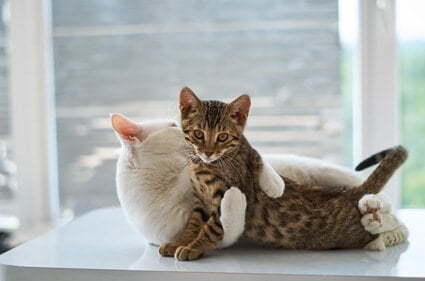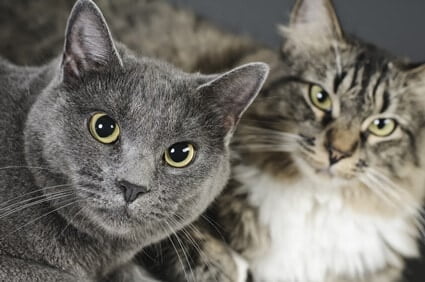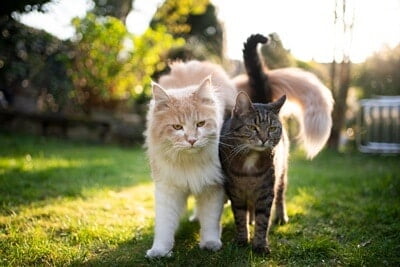Respecting your elders is a common social rule followed by virtually every culture. However, cats don’t abide by the same social rules as we do. So, before you think about getting your older cat a young companion, learn more about how different feline generations treat each other.
Whether or not younger cats respect older cats depends on the cats’ personalities. Some cats are naturally more aggressive than others, which will affect the relationship, no matter the age gap. More than age, matching energies determine the relationship between cats.
A relationship between an older and younger cat is somewhat predictable because of what we know about feline behavior. However, which cat comes out on top is a roll of the dice. Before pairing cats with an age gap, there are various factors to consider.
Do Cats Know How Old Other Cats Are?
Cats know how old other cats are. They may not know the exact age, as cats have no concept of numbers, but they can tell when another cat is older or younger than they are.
Cats can do this because of the way they communicate with each other. Cats have scent glands along different parts of their body, and these scent glands release pheromones that contain unique information about the cat.
When cats rub against one another or sniff each other’s butts, they’re exchanging information in the form of their scent. Once cats have become acquainted in this way, they can tell a lot about each other, such as their:
- Age
- Mood
- How healthy they are
- Gender
Do Cats Respect Older Cats?
Usually, older cats establish boundaries first, and younger cats respect those boundaries. However, many things can get in the way of this dynamic, resulting in a relationship where a younger cat might bully an older one.
This is because younger cats don’t automatically respect older ones. Things like playfulness, illness, and aggression can disrupt a harmonious relationship between two cats.
It’s assumed that younger cats automatically respect older ones because that behavior would mirror how humans treat their elders. It also makes sense in our minds since it is widely believed that social animals operate under a strict hierarchy. Usually, an older, stronger cat would dominate younger, weaker cats.
However, according to Science Direct, both domestic cats and feral cats don’t have a linear hierarchy. The idea that they do stems from a study done on wolves in the 1970s. The Dominance Theory that resulted from this study was later debunked, but the way we think about how social animals operate is still tarnished by the misinformation in the original study.
In truth, social animals benefit from being as egalitarian as possible instead of living under the thumb of an older, stronger alpha. In a group, cats will establish their territory in specific parts of the home by giving each other subtle signs. So, if a younger cat seemingly dominates an older one, it’s because the younger cat was better at establishing boundaries than the older one.
Older cats that aren’t sick are naturally better at establishing these boundaries due to experience, so younger cats will often yield. However, these boundaries aren’t permanent, and they can change if the younger cat takes advantage of the older cat’s condition. When the older cat becomes sick, it might yield to the younger one because it can no longer defend its territory.
Why Do Older Cats Lick Younger Cats?
Licking is one of many ways cats communicate with each other. It is usually associated with mother cats grooming their young, so seeing an older, unrelated cat lick a younger one might be odd.
Even male cats will participate in this behavior, even though male cats do not participate in kitten rearing. This is still a common occurrence because older cats want:
Scent Marking
Scent marking is a way for cats to mark their territory and exchange information with other cats. An older cat that gets along with a younger cat may feel protective of it, despite not being related. It will scent mark the juvenile cat to let other cats know not to get close.
Female cats are especially likely to do this since they often treat kittens as their own out of maternal instinct. Some female cats (queens) aren’t naturally very maternal and will only nurture younger cats once they have had a litter of their own.

Establishing Boundaries
Because cats don’t have a social hierarchy where one dominates the other, what we would think are displays of dominance are just the older cat establishing boundaries. When interacting with a new cat, older cats will discipline them by mounting them and biting their neck.
It’s a way for the older cat to tell the juvenile cat that it was here first. No amount of crying will make it give up its favorite spot on the couch.
Licking is also used to the same effect. Getting licked by another cat is so strongly associated with mothering in a cat’s mind that an older cat will be able to use it to signal to the other. Licking says, “Because I’m the older one, what I say goes.” As long as the juvenile is less aggressive than the older cat, it’ll instinctively do what its elder says.
Licking to establish boundaries is usually accompanied by playfighting. This is a method for the cats to get a feel for each other. So, if you see your cats licking each other before a chase, it’s not because they suddenly despise each other. It’s just another way to get to familiarize themselves with one another.
Show Affection
Grooming each other is a common way for cats to bond. When an old and young cat get along just fine, they’ll lick each other as a sign of affection.
You can tell the licking is affectionate when the grooming is mutual. If you see this behavior, it’s a good sign that your cats get along, despite their differences.
Why Do Younger Cats Attack Old Cats?
Younger cats attacking older cats is more common than you might think. That’s because young cats don’t automatically respect older ones if the latter hasn’t established boundaries properly.
For this reason, you should reconsider getting your older cat a young companion. Although they’re social animals, cats don’t mind being the only feline in a house.
Bringing in a young new cat can disrupt the life your old cat knows, leading to a lot of stress and frustration. The new cat will invade the older cat’s already established territory, leading to heightened tensions on both sides. If things get out of hand and your older cat can’t defend itself, the younger cat will attack.
Juvenile Aggression
A cat’s behavior is determined by its personality and how it was raised as a kitten. A docile cat will stand no chance against an aggressive younger cat, no matter how many years it has on the younger feline.
Many people believe that young cats which attack older ones are simply more dominant. However, this isn’t true. According to Scientific Reports, cats try to avoid direct confrontation as much as possible. Over-aggression is largely linked to early weaning.
Another study from the Journal of Veterinary Behavior describes how a genetic variation in a cat’s oxytocin receptor can lead to over-aggression. So, while most cat behavior can be trained, some cats are naturally aggressive, no matter what age they are.

Juvenile Playfulness
Observe your two cats because what may seem like fighting may be playfulness. Juvenile cats are more energetic than older cats, so they are often incessant in how they demand playtime.
If your older cat stays in one spot and has neutral body language while the juvenile cat “attacks,” it’s in complete control of the situation. If the older cat were in danger, it would be running away with its tail between its legs. The older cat might occasionally hiss or hit the younger one to remind it not to bite too hard, but this is completely normal when felines play together.
Younger Cat Bullying Older Cat
When introducing a young and old cat, you must pay close attention to how they interact for an ongoing period because cat dynamics are constantly changing. You’ll want to be able to separate them if one ends up bullying the other.
Even if they seem friendly during the initial meeting, it’s best to monitor them. Do so until the new cat is fully familiar with its environment and proper territory boundaries have been established. If your younger cat does appear to be bullying the other, you’ll want to:
Separate Them
An otherwise friendly kitten may negatively react when meeting a new cat for the first time. The stress of the car ride, being in a new environment, and being overstimulated by all the new smells can be enough to make it lash out at your old cat.
Separate the cats until the younger one is familiar with their environment. Re-introduce them slowly to each other in a neutral setting until you’re sure they are both comfortable.
Neuter Them
Ensure both cats are neutered, not just for their physical safety but to lower their aggression. Cats, especially males, are more territorial, aggressive, and confrontational when sexually active.
You must spay and neuter your cats if they’re of different genders. This is true even if they have no interest in each other (a rare occurrence if they are both healthy). The stress that comes with the urge to mate can put you and your cats at risk of getting badly scratched and bitten.
Consider Rehoming One of Them
Given what we know about how some cats are genetically predisposed to being aggressive, sometimes, it’s better for both cats to simply part ways forever. Certain felines aren’t meant to live in a multi-cat home. If your young cat is one of them, you should consider rehoming it.
It’s far easier to rehome a younger cat than to rehome an older cat. Older cats tend to be less adaptable than younger ones, so it’s a much harder transition.


I had two cats but my mother is highly allergic so I had my cats live with a friend. He died and left a dog and my two cats. I found someone to rent the house and take care of the dog and two cats. All spayed and neutered. Well she brought home a kitten one day and that kitten had kittens and so on. There are too many cats and one of my cats had died. She was skin and bones. So I go and feed my other cat daily over there and noticed her hiding under a tarp. so i made her a box with blankets and waterproofed it and stuck it under the tarp. I noticed another cat which has kittens of her own, over takes my cat when fed and now she has taken my cats security area which is hiding under this tarp. It breaks my heart to see the suffering and I can’t seem to make this woman see that my cat has been ousted by the colony. She thinks she is so fine and doesn’t see her anxiety while hiding under a tarp. I have been looking for another home for her but it is hard finding anyone who wants her as a companion. I don’t know enough of how colonies work to educate this woman. I see suffering amongs many of the cats and see my cat suffering the most. Please advise